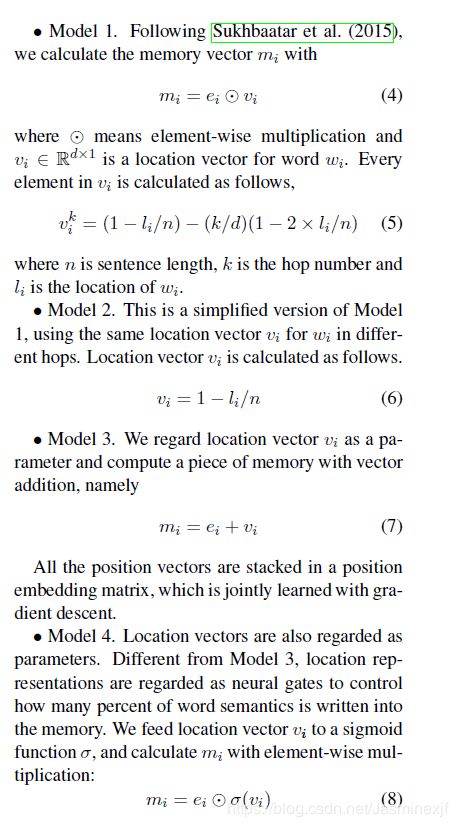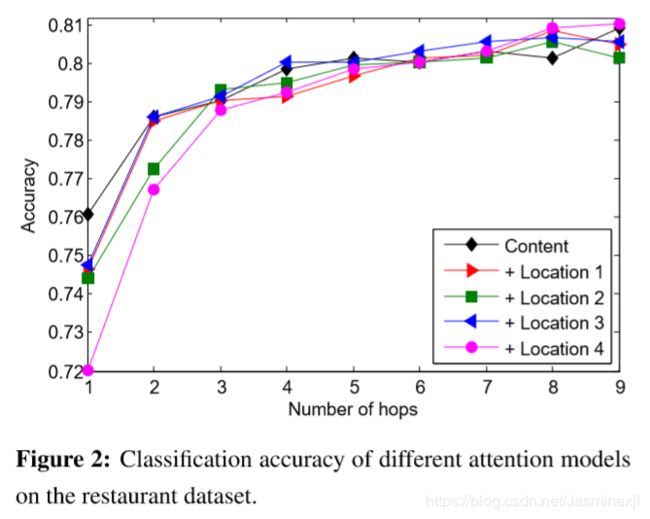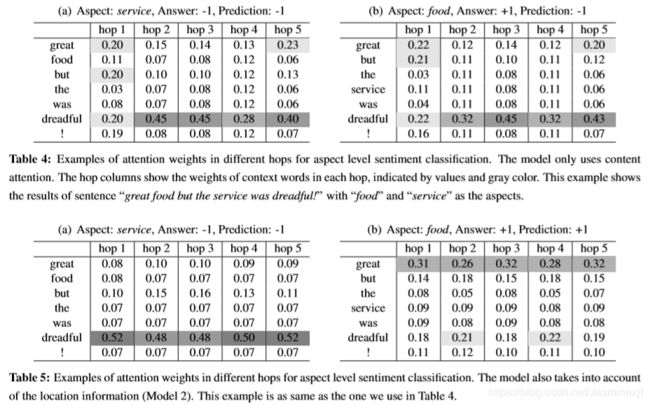方面级分类paper4:Aspect Level Sentiment Classification with Deep Memory Network(2016EMNLP)
the link of paper:《Aspect Level Sentiment Classification with Deep Memory Network》
By :Jasminexjf
Time: 2019-06-24
来源:EMNLP2016
问题:aspect level sentiment classification
参考文章:https://zhuanlan.zhihu.com/p/22841142
一、关于aspect level的情感分析
给定一个句子和句子中出现的某个aspect,aspect-level 情感分析的目标是分析出这个句子在给定aspect上的情感倾向。
例如:great food but the service was dreadful! 在aspect “food”上,情感倾向为pos,在aspect “service”上情感倾向为neg。Aspect level的情感分析相对于document level来说粒度更细。
aspect level情感分析相关工作
- SemEval-2014 Task 4: Aspect Based Sentiment Analysis
- NRC-Canada-2014: Detecting Aspects and Sentiment in Customer Reviews
- DCU: Aspect-based Polarity Classification for SemEval Task 4
- Adaptive Recursive Neural Network for Target-dependent Twitter Sentiment Classification
- Aspect Specific Sentiment Analysis using Hierarchical Deep Learning
- PhraseRNN: Phrase Recursive Neural Network for Aspect-based Sentiment Analysis
- Effective LSTMs for Target-Dependent Sentiment Classification
1:aspect level情感分析的系统介绍;
2、3:传统分类器方法实现aspect level的情感分析;
4、5、6、7:神经网络方法实现aspect level的情感分析。
分类器方法
将情感分析作为一个文本分类问题,用机器学习的方法训练文本分类器。分类器的性能极大依赖于文本特征 text feature、情感词典 sentiment lexicon等信息。目前效果比较好的是SVM。
神经网络方法
利用神经网络学习低维文本特征,获取文本的语义表示。
神经网络模型的问题
传统的神经网络模型能够捕捉背景信息,但是不能明确的区分对某个aspect的更重要的上下文信息。LSTM通过sequence的方式对所有的context word执行同样的操作,因此不能明确反映出不同context word的重要性。而对于aspect-level的情感分析来说,只有一部分上下文信息对于判定某个特定的aspect的情感倾向是比较重要的。
例:great food but the service was dreadful!
在这个句子里,对于“food”这个aspect来说,要判断它的情感倾向,“great”是一个重要的线索,“dreadful”基本没什么用。同样的对于“service”这个aspect来说,“dreadful”比较重要,“great”就没有什么作用了。
解决这个问题的方法
捕捉不同的context word对于特定aspect的重要性,利用这个信息做句子的语义表示。作者的想法来自于memory network。
二、关于memory network
memory network是Jason Weston在14年提出来的想法,Sainbayar Sukhbaatar在15年提出了让memory network进行end to end的训练方法,并在QA上取得了较好的效果。
关于memory network的相关内容可参考下面两篇论文:
- [Weston et al.2014] MEMORY NETWORKS
- [Sukhbaatar et al.2015] End-To-End Memory Networks
memory network的总体说明
按照我的理解,memory network就是有一个可以读写的外部memory,模型可以根据memory的内容来确定输出的符号。memory里面存储需要的信息,比如上下文的语义信息,这样可以解决长期大量的记忆问题
结构
Memory network包括:一个memory m,四个component I,G,O,R
- m:一组vector
- I:把输入转化成interal feature representation
- G:根据新的输入更新old memories
- O:根据当前memory和新的输入得到output representation
- R:根据output representation得到模型输出
以QA为例说明memory network
输入:一系列sentence:,和question q
task:根据这些sentence得到q的答案
- I 每次读一个sentence ,encode得到vector representation;
- G 根据当前的sentence representation更新memory;
- 所有sentence都处理完得到完整的memory m,存储这些sentence的语义信息;
- Encode question q得到;
- O 根据从memory m选择related evidence得到一个输出向量o;
- R 根据o得到最终的输出。
三、本文的算法架构
给定句子![]() 和aspect word
和aspect word ![]()
1、map each word into its embedding vector
这些word vectors包括context vectors和aspect vectors。
aspect vectors:
如果aspect word是单个词,aspect vectors就是aspect word的word embedding;
如果aspect word是多个词组成的,aspect vectors就是几个词的embedding的平均值。
context word vectors:
即sentence中除了aspect word之外的所有词的word embedding堆叠到一起,这就是模型中初始的memory。
2、computational layer
- 模型包括多个computational layers,每个computational layer包括一个attention layer和一个linear layer。
- 第一个computational layer,attention layer的输入是非线性化后的aspect vector,输出memory中的比较重要的部分,linear layer的输入是aspect vector。第一个computational layer的attention layer和linear layer的输出结果求和作为下一个computational layer的输入;
- 其它computational layer执行同样的操作,上一层的输出作为输入,通过attention机制获取memory中较重要的信息,与线性层得到的结果求和作为下一层的输入。
- 最后一层的输出作为结合aspect信息的sentence representation,作为aspect-level情感分类的特征,作为类别softmax的输入。
3、Attention
包括content attention和location attention两部分。
content attention
一方面,不同context word对于句子的语义表示贡献不一样;
另一方面,不同的context word对于特定aspect的情感倾向的重要性也是不一样的。于是就有了content attention。
输入:external memory ![]() 和 aspect vector
和 aspect vector ![]()
输出:![]()
location attention
我们从直观上来看,通常情况下,与aspect word距离较近的context word对于相应aspect的情感倾向的判断更重要。于是就有了location attention。所谓的location attention其实就是把context word的位置信息加入到memory中。
location of the context word 的定义:absolute distance with the aspect word in the original sentence.
作者定义了四种模型来encode位置信息:
4、分类
- 最后一层的输出作为特征
- Softmax
- 交叉熵
四、实验
1.数据集
2.结果:
从以上结果可以看到memory network的方法在两个数据集上都取得了不错的效果。
3.运行时间对比:
4. 4中不同location attention 结果对比
根据上图可以看出:
- 随着computational layers的增多,分类准确率有提升;
- 在computational layer数大于5的时候,四个模型准确率相差不大;
- model 2计算量最小,准确率也不差。
5.计算单元层数和location信息的作用分析
从Table 4和Table 5可以看出:
- 增加computational layer可以提取更abstractive的evidence(针对某个特定的aspect),更好的区分不同context word对特定aspect的贡献;
- 引入location信息明可以更好地捕获针对特定aspect更重要的context信息。
五、总结
1、作者将memory network的思想用在aspect-level的情感分析上,通过上下文信息构建memory,通过attention捕获对于判断不同aspect的情感倾向较重要的信息,在实验数据集上取得了较好的结果。和RNN、LSTM等神经网络模型相比,本文提出的模型更简单计算更快。
2、将content信息和location信息结合起来学习context weight是一种比较适合aspect-level的情感分析的方法,对模型性能有较大提升。
3、多层计算单元可以学到更多更abstractive的信息,可以提升模型性能。







